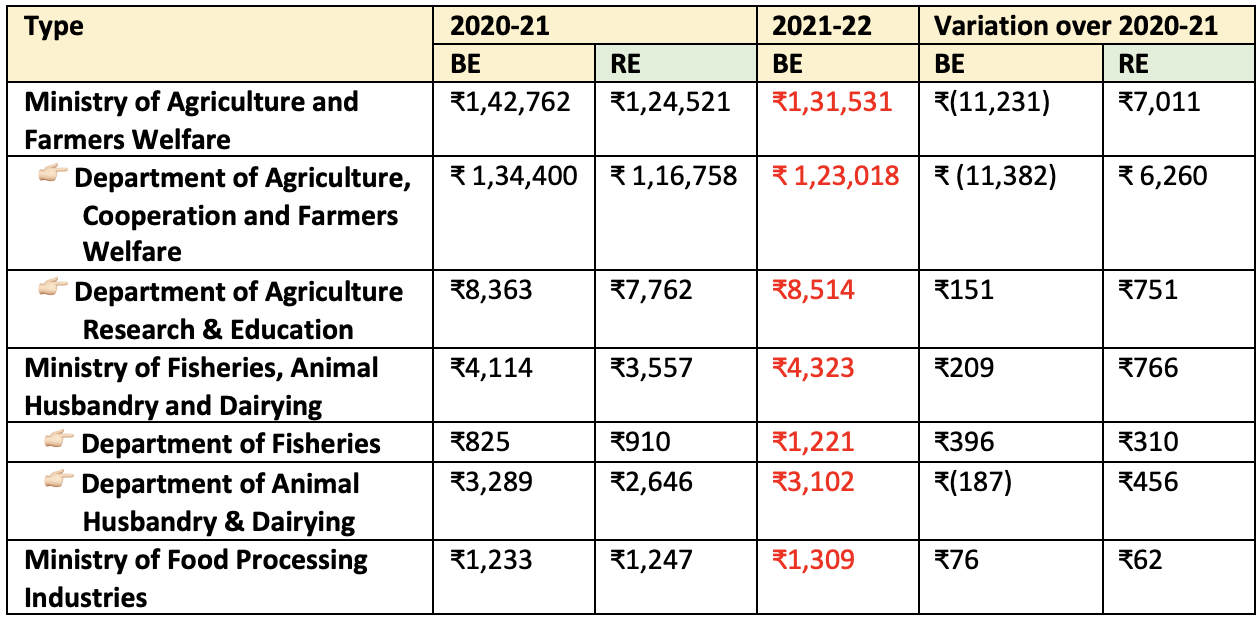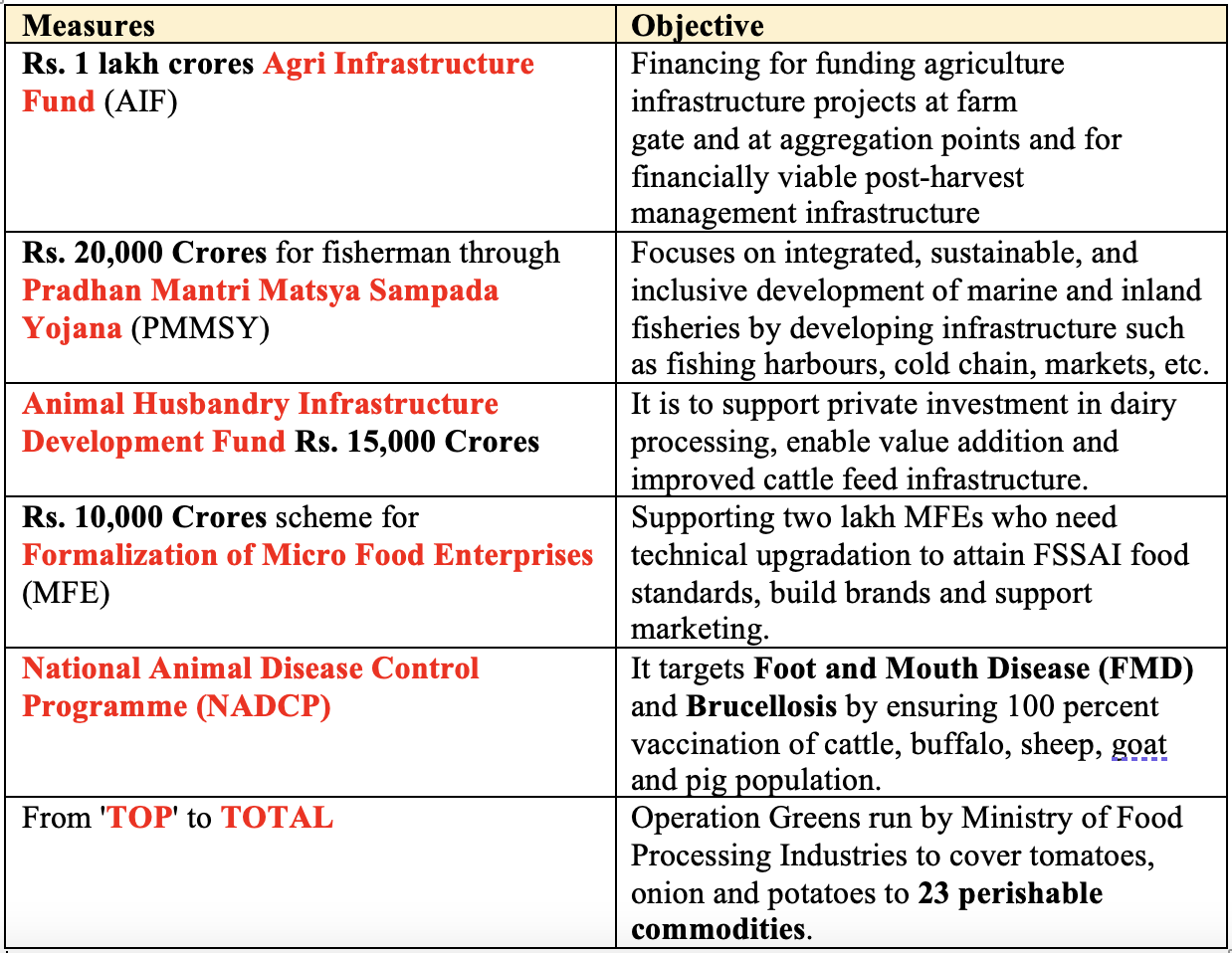Agricultural Budget Analysis 2021-22
Budget 2021-22
The Economic Survey (2020-21) stated that the agriculture and allied sectors were the sole bright spot amid the slide in performance of other sectors, clocking a growth rate of 3.4 percent at constant prices in 2020-21. Notwithstanding challenges posed by lockdown, there were mostly uninterrupted supply of agriculture commodities including rice, wheat, pulses, fruits, vegetables, milk and livestock products to the consumers.
Six pillars of the Union Budget 2021-22
- Health and Wellbeing
- Physical & Financial Capital, and Infrastructure
Inclusive Development for Aspirational India- Reinvigorating Human Capital
- Innovation and R&D
- Minimum Government and Maximum Governance
👉🏻 Agricultural Budget is under Piler 3. Inclusive Development for Aspirational India
👉🏻 Total Indian budget size is 34,83,236 Cores.
Budget Allocations across Agriculture and Allied Ministries

- As it can be seen that their is a reduction in the budget of Ministry of Agriculture, which does not show the true picture. This reduction can be explained by reductions in PM-KISAN allocations.
- As there were more registered beneficiaries (11.62 crore) then actual PM-KISAN beneficiaries (10.04 crore).
- According to Agricultural Census 2015-16, there are
14.5 crore farmers familiesin the country.
Major Announcements
MSP Operations Bring Financial Benefits to Farmers
- During budget speech Finance Minister Nirmala Sitharaman assured that the government is commited to Minimum Support Price (MSP) at least 1.5 times the cost of production across all commodities.
- Also she stated that “The procurement has also continued to increase at steady pace. This has resulted in increase in payment to farmers substantially”. The Finance Minister elaborated on financial benefits to farmers under the MSP operation especially during 2013-14 and 2020-21.
- In case of wheat, the total amount paid to farmers in 2013-2014 was Rs. 33,874 crores. In 2019-2020 it was Rs 62,802 crores. In 2020-2021, the amount, paid to farmers for procurement of wheat rose to Rs. 75,050 crores. The number of wheat growing farmers that were benefitted increased in 2020-21 to 43.36 lakhs as compared to 35.57 lakhs in 2019-20.
- For paddy procurement, the amount paid to farmers in 2013-14 was Rs. 63,928 crores. In 2019-2020, this amount rose to Rs. 1,41,930 crores. In 2020-2021, this is further estimated to rise to Rs. 172,752 crores. The number of farmers benefitted from MSP operations in paddy rose from from 1.24 crores in 2019-20 to 1.54 crores in 2020-21.
- In case of pulses purchase, the amount paid to farmers in 2013-2014 was Rs. 236 crores. In 2019-20 it increased to Rs. 8,285 cores. In 2020-2021, it is estimated at Rs. 10,530 crores, a huge increase of more than 40 times from 2013-14.
- Similarly, the receipts to cotton farmers rose from Rs. 90 crores in 2013-14 to Rs. 25,974 crores as on 27th January 2021.
Quantity Purchased at MSP Value Purchased at MSP

Reiterated Commitment to MSP
- The government through the Budget has also reiterated their commitment to the minimum support price (MSP) the public procurement system. The Finance Minister highlighted the government’s commitment on procurement through MSP by announcing the achievements attained through support price. The number of farmers benefited increased from 35.57 lakh in 2019-20 to 43.36 lakh in 2020-21 in case of wheat and from 1.24 crores in 2019-20 to 1.54 crores in 2020-21 in rice.
- Through these figures government showed that it is committed to the promise of MSP
- It is expected that this will put rest to large misconception in the country about dissolution of government owned APMC markets.
Agricultural credit target enhanced to Rs. 16.5 lakh crore
- The target for agriculture credit has been increased by Rs. 1 lakh crores to stand at Rs.
16.5 lakh coresfor 2021-22. This increased target is expected to be met by increased demand from allied sectors such as animal husbandry and fisheries; promoting diversification of farm incomes as well. - The provision by more than four times in the last decade from Rs. 3,75,000 of agricultural credit has increased crores (2010-11) to Rs. 16, 50,000 crores (2021-22), considering the importance of agriculture in contributing in rural employment, farmers’ well-being and specially to support farmers in doubling their income.
- This will provide much needed working capital requirements to large number of farmers
who usually borrow for informal sources at higher rate of interest.

RIDF to be enhanced to Rs. 40,000 crore
- Government of India created the RIDF in NABARD in
1995-96, with an initial corpus of Rs. 2,000 crore. - Another step towards investment in agriculture is reflected in a 33 percent increase in the budgeted amount under Rural Infrastructure Development Fund (RIDF) of Rs. 10,000 crore. These enhanced expenditures on rural infrastructure are likely to benefit farmers in several ways, as there are 37 areas where the RIDF funds can be deployed, including not just agriculture infrastructure, but also social sector infrastructure such as public health institutions, sanitation, solid waste management amongst others.
Micro Irrigation Fund enhanced to Rs. 10,000 crore
- To further the adoption of more efficient irrigation systems, the Micro Irrigation Fund created under NABARD has now been doubled from Rs. 5,000 crores to
Rs. 10,000 crores. More efficient irrigation systems in turn promote sustainability and conserve water, a precious natural resource, and are critical to the long-term health of not just the agriculture sector but the whole of India. - The objective of the fund is to facilitate State Govts. efforts in mobilizing additional resources for expanding coverage under micro irrigation and incentivizing its adoption beyond provisions of PMKSY-PDMC.
Operation Green Scheme to be extended
- Operation Green Scheme to be extended to 22 perishable products, to boost value addition in agriculture and allied products
- Diversification is an important pillar in the quest to double farmers’ income.
- The Operation Green Scheme was launched to strengthen production clusters, FPOs, connecting them to terminal markets, invest in post-harvest infrastructure to reduce losses and increase food processing capabilities. Initially the scheme covered tomatoes, onions and potatoes. Now, the scheme has been extended to cover 22 perishable commodities, which will further support diversification at the farm level.
- Ministry of Food Processing Industries (MoFPI) launched Operation Greens scheme in November,
2018for integrated development ofTomato, Onion and Potato (TOP)value chain with the objectives to enhance value realization of TOP farmers; reduction in post-harvest losses; price stabilization for producer and consumers and increase in food processing capacities and value addition etc. - The scheme provides for short term intervention by way of providing transportation and storage subsidy @ 50% and long term intervention through value addition projects in identified production clusters with Grant-in-aid @ 35% to 70% of eligible project cost subject to maximum of Rs. 50 crore per project.
- As per budget Announcement 2021-22, expanded operation greens scheme
covers 22 perishablesincludingshrimp. - Farmers can transport any notified fruits and vegetable crops through
Kisan Rails. - Railways would charge only 50 percent of freight charges on these fruits and vegetables.
- Remaining 50 percent of the freight charges will be provided as subsidy under Operation Greens Scheme by Ministry of Food Processing Industries to the Indian Railways.
- At present, Railways operating
three Kisan RailsDevlali (Maharashtra) to Danapur/Muzaffarpur (Bihar), Anantapur (Andhra Pradesh) to Adarsh Nagar (Delhi) and, Yashwantpur (Karnataka) to Delhi. The fourth Kisan Rail from Nagpur (Maharashtra) to Delhi will commence soon.
One Thousand more mandis under eNAM
- Around 1.68 crore farmers registered and Rs. 1.14 lakh crore of trade value carried out through e-NAMs;
1,000 more mandisto be integrated with e-NAM to bring transparency and competitiveness. - According to the agriculture ministry official, e-NAM is digital platform which aims to benefit the last-mile farmer and transform the way they sell their agri. produce through transparent competitive bidding for arriving at a remunerative price for farmers.
APMCs to get access to the AIF
- APMCs to get access to the Agriculture Infrastructure Funds for augmenting infrastructure facilities.
- Financing facility of
Rs. 1,00,000 crorewill be provided for funding Agriculture Infrastructure Projects at farm-gate & aggregation points (Primary Agricultural Cooperative Societies, Farmers Producer Organisations, Agriculture entrepreneurs, Startups, etc.) - Development of infrastructure, especially at the farm game and post-harvest stage minimizes wastages and shortages. The post-harvest losses and wastages, due to lack of proper infrastructure facilities, accrues to 15-20 percent.
- The Agriculture Infrastructure Fund (AIF) announced by the government in Aatm Nirbhar Bharat Abhiyan in May 2020 with the total corpus of Rs. One lakh crore is a huge step in the right direction.
- It will mobilise medium and long term debt finance facilities for investment in viable projects for post-harvest management.
- The allocation for the upcoming fiscal is pegged at Rs. 900 crore. It is expected to push entrepreneurs for innovation by leveraging new age technologies including Internet of Things, Al, etc; to reduce post-harvest losses and increase value realisation for farmers.
- While the scheme is already available for entrepreneurs, farmer producer organisations (FPOs), cooperative societies and startups, the budget speech made an important announcement that even APMC market yards would be able to utilise this fund to upgrade their marketing infrastructure. This reiterates the government’s commitment to strengthening the APMC system as well.
- All loans under this financing facility will have interest subvention of 3% per annum up to a limit of ₹ 2 crore. This subvention will be available for a maximum period of 7 years. In case of loans beyond ₹ 2 crore, then interest subvention will be limited up to ₹ 2 crore.
🙋🏼 Where the money for AIF comes❓
- This will be thorugh a new kind of cess, Agriculture Infrastructure Development Cess.
- Cess is a kind of special-purpose tax which is levied over and above basic tax rates.
- The new cess will be levied on 29 products, prominent among which are gold, silver, imported apple, imported alcohol (excluding beer), imported pulses, imported palm oil, imported urea, and petrol/diesel including branded ones.
- The cess will be levied on petrol and diesel at the rate of Rs 2.5 and Rs 4 per litre respectively.
SWAMITVA Scheme to be extended to all States/UTs
- Another major announcement was the extension of the
Survey of Villages and Mapping with Improvised Technology in Village Areas (SVAMITVA)scheme to the whole country. - The SWAMITVA Scheme was piloted in 2020 to map rural residential land ownership and to create non-disputable records, leveraging advanced technologies, such as drones for measurement.
- The scheme has now been extended to all states and UTs. The scheme will be implemented in a phased manner over a period of four years (2020-2024) and would eventually cover around
6.62 lakh villagesof the country. - This will benefit farmers by providing them with non-disputable records of land ownership, facilitating access to bank credit and the inherent security of owning records of ownership; thus, reducing land disputes and litigation.
Fisheries
- Investments to develop modern fishing harbours and fish landing centres – both marine and inland.
- 5 major fishing harbours –
Kochi,Chennai,Visakhapatnam,Paradip, andPetuaghatto be developed as hubs of economic activity. - Multipurpose Seaweed Park in
Tamil Naduto promote seaweed cultivation. Seaweed farming is an emerging sector with potential to transform the lives of coastal communities. There is a great demand for sea weed, which has medicinal properties, in India and abroad. Sea weed cultivation helps in empowerment of the fishing community, especially women. - The fisheries sector also carries with potential to significantly increase farmers income. Substantial investment opportunities were highlighted to enhance the Blue Economy, specifically in modern fishing harbors and fish landing centers.
- The budget allocation for department of Fisheries has increased by whopping 48 percent from a budgeted estimate of Rs. 825 crore in 2020-21 to
Rs. 1220.84 crorein 2021-22. - The major element in the fisheries sector is attributed to Pradhan Mantri Matsya Sampada Yojana (PMMSY) with the allocation of
Rs. 1000 crore, contributing more than 80 percent of overall allocation to fisheries department.
Expenditure on Major Subsidies
- Government mainly four types of subsidies i.e.
Food,Fertilizer,PetrolandOthers. The budgeted allocations of interest subsidy on short-term credit to farmers in FY 2021-22 areRs. 19,468 crore. This is slightly lesser than previous year’s budgeted amount of Rs. 21,175 crore.
- The budget also deserves applause for bringing greater transparency in reporting of expenditures, especially for food and fertiliser sector. There were outstanding dues of food subsidy which was not reflected in the budget and was accounted as borrowings of Food Corporation of India. Over the years, these borrowing accumulated and crossed Rs. 3 lakh crore. The budget witnessed revision in the figure of food subsidy to Rs. 4,22,618 crore in revised estimates of FY 21 from a budgeted figure of Rs. 1,15,570 crore in the 2020-21 financial year, an increase of 3.6 times.
- This year all the borrowings of FCI have been cleared and budget reflected the true picture of food subsidy. The budgeted amount for coming fiscal year is stands at Rs. 2,42,836 crore.
- Similarly, the arrears of fertiliser sector were also clear. The revised estimates are increased by 1.8 times from Rs. 71,309 crore for FY 2020- 21 to Rs. 1,33,947 crore. For F 2021-22, things are likely to smoothen with a budget provision of Rs. 79,530 crore.
Five Mini-Budgets
PMGKY(Pradhan Mantri Garib Kalyan Yojana),three ANB packages(ANB 1.0, 2.0, and 3.0), and announcements made later were like 5 mini-budgets in themselves- Major announcements for Agriculture and Allied Sector under the
AatmaNirbhar Bharat Abhiyaan.

Scheme wise allocation

Agriculture Schemes

Rural Development Schemes
References
- https://prsindia.org/budgets/parliament/union-budget-2021-22-analysis
- https://cacp.dacnet.nic.in/
- https://dfpd.gov.in/food-grain-bulletin.htm
- https://www.indiabudget.gov.in/
- https://fci.gov.in/
- http://www.nafed-india.com/
- https://cotcorp.org.in/msp
- Kurukshetra
Budget 2021-22
The Economic Survey (2020-21) stated that the agriculture and allied sectors were the sole bright spot amid the slide in performance of other sectors, clocking a growth rate of 3.4 percent at constant prices in 2020-21. Notwithstanding challenges posed by lockdown, there were mostly uninterrupted supply of agriculture commodities including rice, wheat, pulses, fruits, vegetables, milk and livestock products to the consumers.
Six pillars of the Union Budget 2021-22
- Health and Wellbeing
- Physical & Financial Capital, and Infrastructure
Inclusive Development for Aspirational India- Reinvigorating Human Capital
- Innovation and R&D
- Minimum Government and Maximum Governance
👉🏻 Agricultural Budget is under Piler 3. Inclusive Development for Aspirational India
👉🏻 Total Indian …
